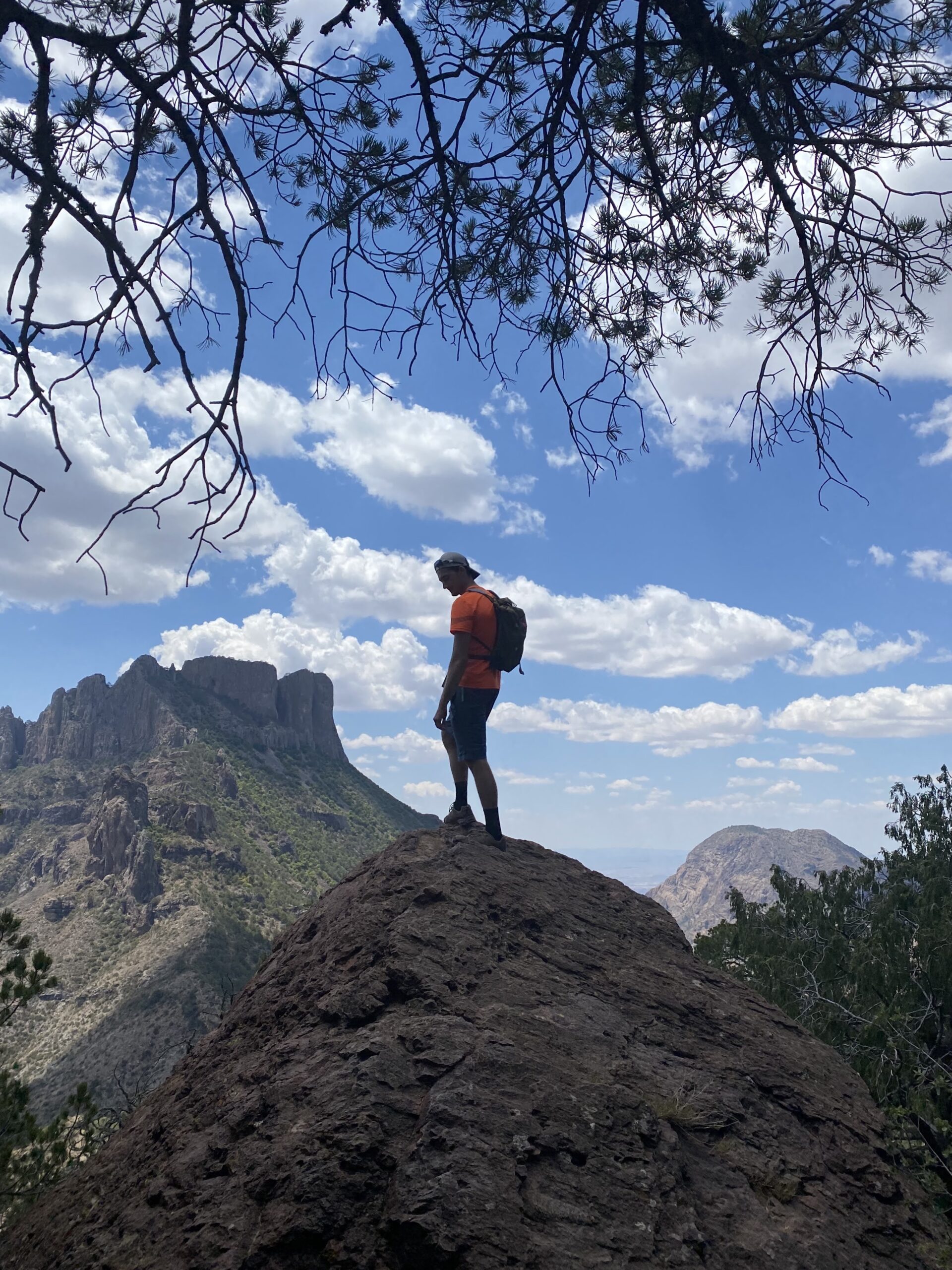Day 2: Escape from the Desert
After a night of mediocre sleep, Shane and I awoke to a dry 85-degree morning and a beautiful sunrise. We loaded up our packs with nearly 20 liters of water in preparation for the day. Our goal was to hike the South Rim plus Emory Peak, estimated at ~15 miles round trip with 3,200 feet in elevation gain. We had a hell of a day in front of us.

We drove back into Big Bend as the rising sun cast wondrous shadows among the approaching Chisos Mountains. The beautiful morning increased my eagerness about the day’s hike, as we looked to have perfect weather ahead of us.

A Black Bear?
As we turned onto Chisos Basin Road – the final approach into the mountains – we saw a large shape moving off to the left. We stopped the car and looked out the driver’s window to find… a black bear?! No… surely this was a glitch in the simulation. Why the heck would there be a black bear in the middle of the desert?
As it turns out, the Chisos Mountains house a “mini-ecosystem” within its more temperate climate. The higher elevation and geography compared to the surrounding desert supports many flora and fauna that most of western Texas cannot. Black bears, mountain lions, bobcats, deer, and colorful birds can all be found in the area. So, while seeing a wild black bear – a first for me – near the Mexican-American border was a huge surprise, it made perfect sense after discussing further with some park rangers.

To the South Rim
Shane and I loaded up our packs and began our hike around 9:30 AM. We decided to hike the South Rim loop trail counterclockwise. This meant that our first notable stop was Laguna Meadow, situated about ~1800 feet higher than the Chisos Basin Visitor Center, where we parked. We stopped for the occasional photo as we climbed out of the basin and trudged through varied ecosystems. We passed by fields of wildflowers and through groves of trees while the trail rose and fell in front of us. As the sun rose higher, we were greeted by increasing cloud cover that shielded us from its heat. In the distance, we could see the barren desert through openings in the mountains.
Visit Paul in the Parks for more national park travel tips!
At 12:30 PM, we finally reached the South Rim – a view unlike any I had seen before. As we stood atop the rim’s cliff faces, we observed the ground that dropped over a mile in front of us. Since Big Bend is so far from – well – anything, there was little-to-no air pollution to obscure our view. We could see at least 50 miles in any direction, and it was magnificent. The Santa Elena Canyon, the “Mule Ears” rock formation, the Rio Grande, and so many more things were visible from our perch.

The South Rim embodies the phrase “pictures don’t do it justice.” Shane and I spent an hour traversing the cliff line and absorbing the views. While we took many photos, it was hard to capture the majesty in front of us. Except for one other pair of hikers, we were completely alone in our spot. We enjoyed complete silence, which was only perturbed by a slight breeze coming from the south.



To Emory Peak
At 1:30 we decided to move on, beginning our journey to Emory Peak. We trudged through forests, a dried creek bed, and rocky ravines as we made our way back north. Shane observed how our surroundings felt like a completely different world than the one we’d just left, and I agreed. For ~an hour, we no longer could see the distant mountains and desert. If someone had told me we were hiking somewhere in Colorado, I could have easily believed them. Eventually, we punched out into Boot Canyon, catching glimpses again of the surrounding mountains.


Finally, we reached the trail split that took us to Emory Peak. The 3.5-mile out-and-back detour was worth every ounce of sweat. The steep trail grew increasingly rocky as we ascended: by the time we reached the top, the hike had turned into a scramble over massive boulders. We were greeted by another helping of 50-mile views in every direction. A marker in one of the rocks reminded us that we had reached the highest point in the park. Dozens of ladybugs flew around us and crawled on our bags and clothes, an odd but fascinating feature of the peak.

Back to the Desert
At around 4 PM, we began our return to the Chisos Basin parking lot. During the final miles, we weaved our way through rocky spires known as the Pinnacles. We observed deer, birds, cacti, unique red-barked trees, and interesting views of Casa Grande. We reached the parking lot shortly after 6 PM. According to my phone, we had walked 36,377 steps, 19.4 miles, and ascended 197 floors. I had consumed over 8 liters of water, and Shane had consumed over 9. The day was the most intensive and rewarding day of hiking I had ever completed.

We returned to our campsite in the desert as the sun began to set. We concluded our day with dinner, a Zoom call with our Purdue friends, and lots of Bulleit bourbon. Whilst drunk, we ventured out into the desert adjacent our campsite and observed the night sky. The lack of light pollution in that part of Texas makes for one of the most crystal-clear night skies in the country. I aspire to one day purchase a better camera that will allow me to capture that sky.
